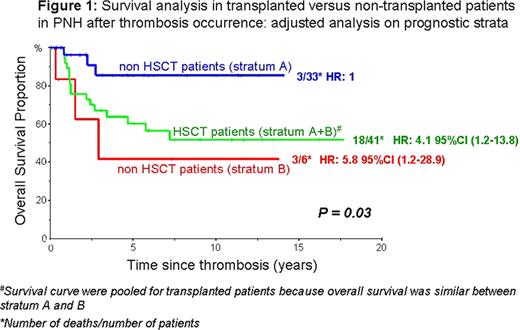Abstract
Abstract 2403
Hematopoietic Stem Cell Transplantation (HSCT) is the only curative treatment for paroxysmal nocturnal hemoglobinuria (PNH). However, the risk of treatment-related mortality (TRM) usually leads to postponing HSCT in PNH until disease progression (especially in case of life-threatening thromboembolism (TE) or severe aplastic anemia (SAA)). Recent studies demonstrated that eculizumab, a C5-inhibitor, is highly effective in reducing intravascular hemolysis with protective effect on the risk of TE. Today, identifying PNH patients (pts) who may benefit from HSCT represents a particularly difficult challenge. We thus conducted an overall survival (OS) comparison between a cohort of transplanted PNH pts and a matched cohort of non-transplanted PNH pts before the eculizumab era. Patients and methods: This retrospective multi-center study was conducted through the SAA WP of the EBMT and the SFH. Between 1978 and 2008, 211 pts with PNH who were transplanted have been reported to the EBMT registry. Data concerning another 401 non-transplanted PNH pts came from the SFH (Peffault de Latour Blood et al., 2008). The OS comparison between the 2 cohorts was performed from the time of life-threatening complication occurrence among pts who experienced the same type of complication, being either TE or SAA. Among pts who experienced one of these complications, two matching procedures were applied in order to select non-transplanted pts comparable to transplanted pts. First, an individual matching procedure was completed using the following complication occurrence criteria: severity, patient age (per decade), year (per decade), and the delay between diagnosis of PNH and complication occurrence (relatively to 3 or 6 months). In addition, the survival time from complication for a non-transplanted patient should be longer than the delay from the complication to HSCT for the corresponding transplanted patient. In a second step, a global matching procedure was performed using the same qualitative prognostic factors. For each factor related to OS within one cohort, a category was discarded from the analysis in the absence or too few numbers of pts in one cohort. After these selections, OS-related factors allowed us to define strata through their combination. OS comparisons between cohorts were performed by using proportional hazards models stratified on each individual matched pair, or adjusted on strata to allow interaction test between cohort and stratum. Results: After a median follow-up time of 5 yrs, the 5-yr OS rate (SE) was 68% (3%) in the transplanted pts group (75 received HSCT from unrelated donors). The only factor associated with OS was the indication for HSCT with worse outcome when the indication was TE (p=0.03). In the non-transplanted cohort, the 5-yr OS rate was 83% (2%) after a median follow-up time of 7 yrs. From the 122 pts diagnosed with TE in the SFH cohort, 92 were eligible for the matched-pair analysis, while from the 47 pts who were transplanted for TE in the EBMT population, 42 were eligible. We then identified 24 pairs of transplanted and non-transplanted pts eligible for the matched-pair comparison. Worst OS was observed for transplanted pts (p=0.007, HR=10.0 [95%CI, 1.3 – 78.1]). In the global matching analysis, we derived 2 prognostic strata: stratum A (age <30 yrs and delay from diagnosis of PNH to TE ≥ 3 months, or delay < 3 months) and stratum B (age ≥30 yrs and delay from diagnosis of PNH to TE ≥ 3 months). Adjusted analysis on prognostic strata is presented in Figure 1 . From the 141 pts experiencing SAA in the SFH cohort, 99 were eligible for the matched-pair analysis, while from the 119 pts who were transplanted for SAA in the EBMT population, 100 were eligible. We then identified 30 pairs of transplanted and non-transplanted pts eligible for the matched-pair comparison. Worst OS was observed for transplanted pts, but the difference was not statistically significant (p=0.06, HR=4.0 [0.9–18.9]). The global matching was not feasible for pts experiencing SAA because the procedure led to too many strata. Conclusion: Our analysis indicates that HSCT is probably not a good treatment option for life-threatening TE in PNH pts. We can make no conclusions regarding PNH pts experiencing SAA due to the impossibility to perform the global matching procedure. These results are of particular importance in the eculizumab era to help physicians in the management of PNH pts, especially pts with TE.
Peffault de Latour:Alexion: Consultancy, Research Funding.
Author notes
Asterisk with author names denotes non-ASH members.


This feature is available to Subscribers Only
Sign In or Create an Account Close Modal